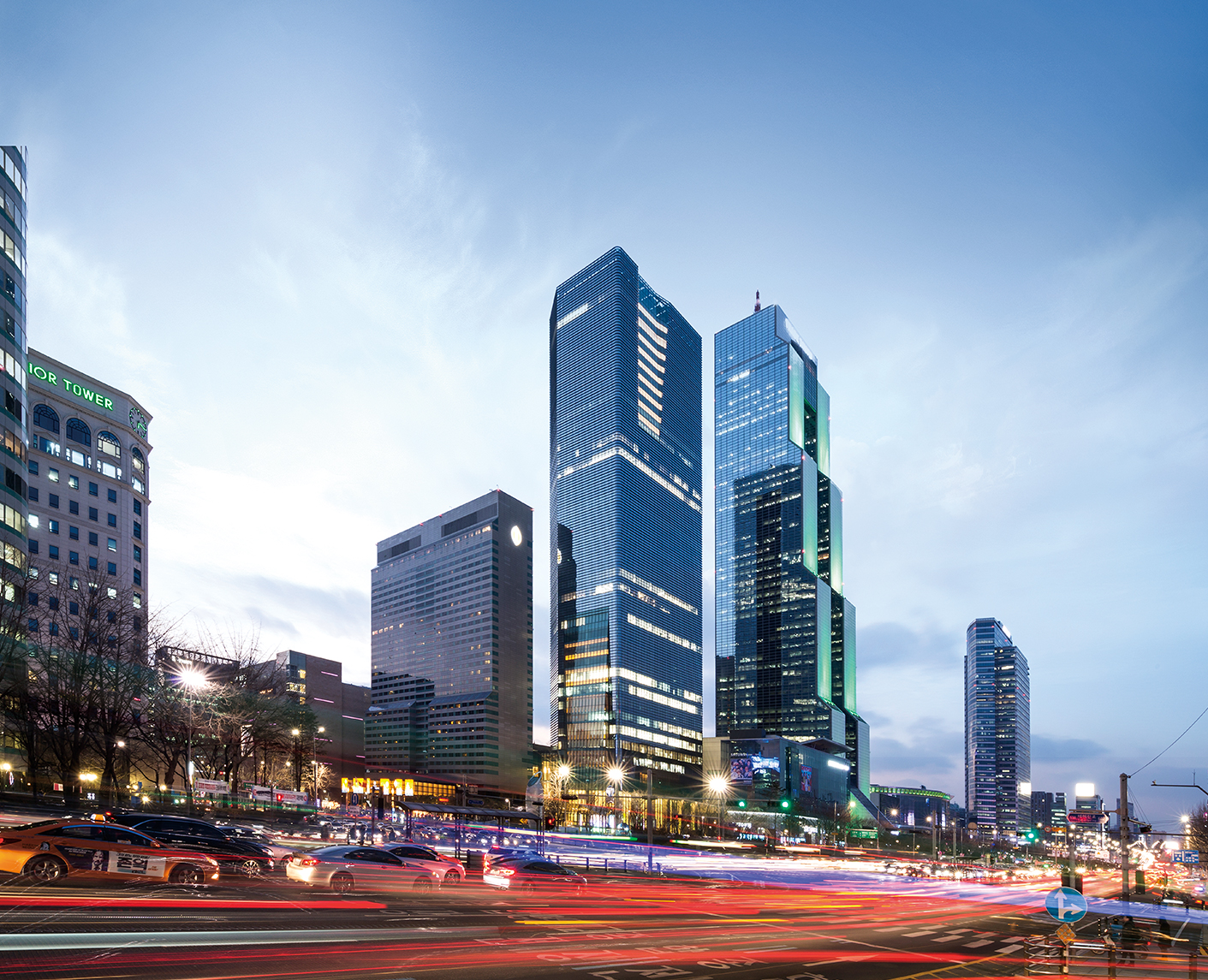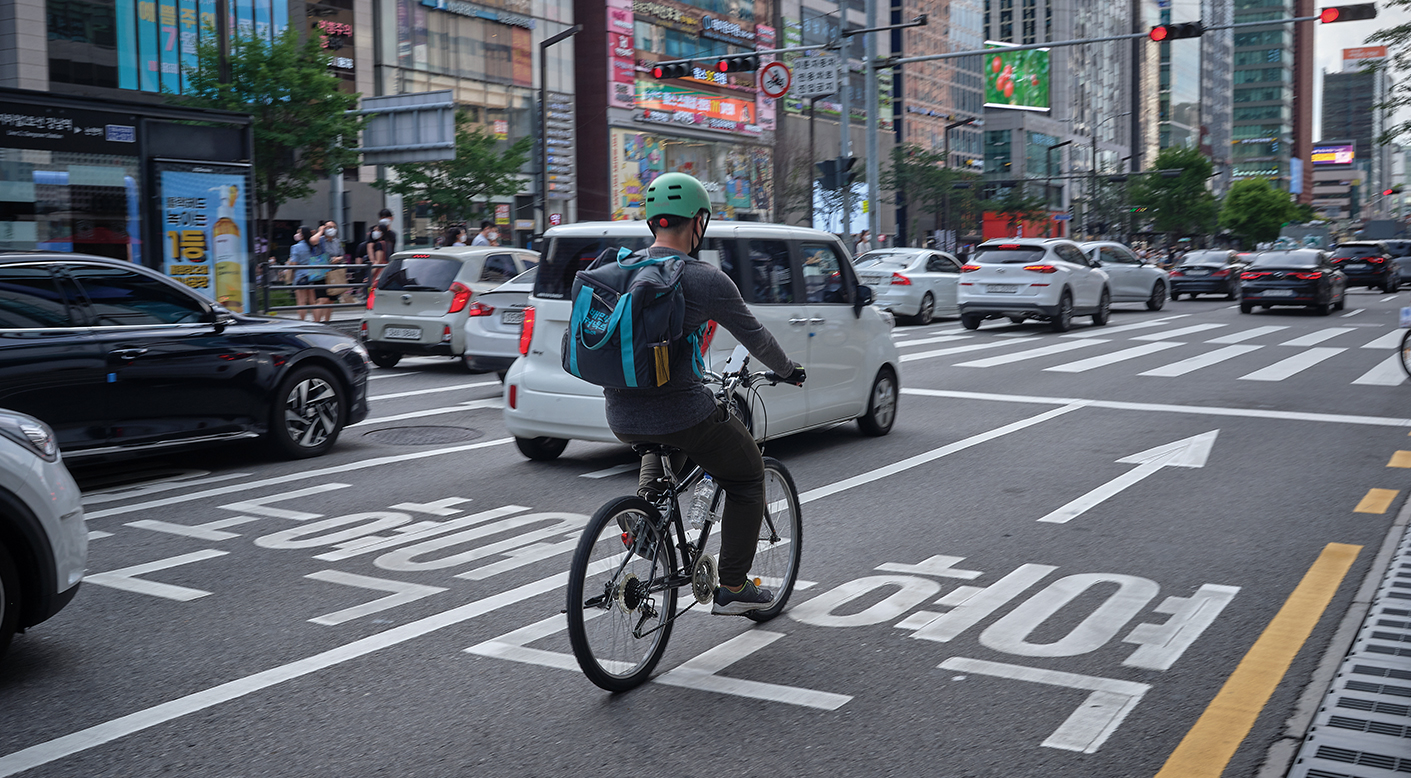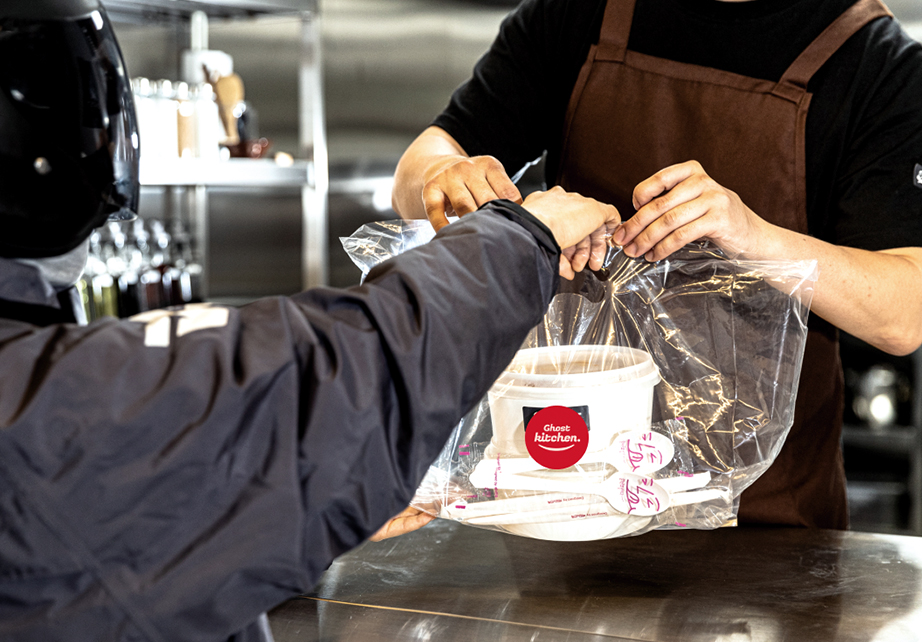August 2021

August 2021
Known throughout the world thanks to pop artist PSY’s hit “Gangnam Style,” Seoul’s posh Gangnam district serves as the city’s commercial heart and its leading trend setter. Perhaps unsurprisingly, then, the area has also become a test bed for Korea’s cutting-edge delivery solutions. From kickboard deliveries to robots, Gangnam is pointing to the future of last-mile logistics.
Written by
Robert Koehler,
contributing writer
Photographed by
Studio Kenn

Gangnam is a glittering tribute to Korea’s post-war economic miracle.
Literally “south of the river,” the greater Gangnam area consists of three tony districts south of the Hangang River: Gangnam-gu, Seocho-gu and Songpa-gu. Today, the area is the economic and cultural heart of the modern capital city, with its dense canyons of glass and steel skyscrapers, gleaming corporate headquarters, posh residential districts, massive shopping centers, influential entertainment companies and―at least in the pre-COVID days―swarming crowds.
Koreans widely regard Gangnam as the most affluent district in the county, akin to Beverly Hills in Los Angeles or New York’s Upper East Side. But to truly understand what a marvel Gangnam is, it’s helpful to know what was there before.
Before the 1960s, what is now Gangnam was little more than rice fields; indeed, Seoul’s sole extension south of the river was the gritty industrial district around Yeongdeungpo. As Korea’s economy began to boom from the 1960s, however, the authorities made a major push to develop the swaths of land south of the Hangang River, which traditionally defined the southern limit of Seoul. The decision was largely driven by population pressures―by 1960, the capital city’s population had grown to 2.45 million, up 1.5 million from just a decade previous.
Gangnam’s historical youth has allowed the area to develop free of some of the cultural and technological constraints faced by older parts of the city. Combined with its high population density and astronomical local purchasing power, Gangnam’s embrace of the new―and especially technology―has encouraged new delivery trends to take root in the district. In the COVID era, this has turned the area into something of a test bed for future delivery and logistics solutions.
 Gangnam’s density and large numbers of single-person and two-person households, as well as its many office workers, generate high demand for delivery services. © imagetoday
Gangnam’s density and large numbers of single-person and two-person households, as well as its many office workers, generate high demand for delivery services. © imagetoday
Skyrocketing demand for non-contact online services is driving the growth of the so-called “quick commerce” industry. If overnight delivery was the gold standard of traditional e-commerce, quick commerce―or Q-commerce, for short―gets you your items in 30 minutes or less. The model marries traditional e-commerce practices with the latest innovations in last mile logistics and big data analysis and AI to get orders where they need to go in as little time as possible.
Q-commerce has largely focused on grocery deliveries, but companies are expanding services to consumer goods as well.
With its tech-friendly, affluent population and legions of office workers, Gangnam has naturally become the country’s Q-commerce hub. Services such as Baedal Minjok’s B Mart and Mesh Korea’s Vroong have established micro fulfillment centers, of MFCs, throughout the Gangnam area. These serve as local warehouses that put items within striking distance of their potential customers.

 © shutterstock
© shutterstock
Delivery companies have been at the forefront of so-called e-mobility as well.
It’s no longer enough to get items where they need to go quickly. You have to do it cleanly as well.
Q-commerce company Vroong, for instance, uses small-scale electric cars to deliver items throughout Gangnam. Barogo, another major Korean delivery company, is researching battery swapping stations for installation at MFCs across the country.
While motor scooters were the preferred means of delivery in the past, bicycles, electric bikes and even kickboards are now ubiquitous. Even the delivery people of Korea Yakult who deliver the company’s drinkable yogurt products have discarded their iconic handcarts in favor of small-scale refrigerated electric cars.
From 30-minute deliveries to
robots, Gangnam points to the
future of last mile logistics.
 Many delivery companies rely on bikes and small electric cars to foster a cleaner environment.
Many delivery companies rely on bikes and small electric cars to foster a cleaner environment.
Shared kitchens are growing increasingly popular as well. As the name suggests, these businesses provide spaces, cooking utensils and cooking equipment to businesses at hourly or monthly rates. Increasingly, they also handle deliveries as well, making them perfect for newer chefs unable or unwilling to pay for spaces of their own.
In Gangnam, they are taking things a bit further. One leading shared kitchen platform, Ghost Kitchen, has moved into Gangnam. It offers chefs facilities optimized for eateries that do most of their business via delivery. It runs kitchens near Gangnam Station and Samseong-dong.
Another shared kitchen, Monki, opened a shared kitchen in a major office building in Tehran-ro, Gangnam’s financial and tech district.
In essence, Monki serves as a food court for local office workers, giving renters not only a good source of income, but also plenty of opportunities to make names for themselves. In fact, even established names such as Michelin-recognized Korean restaurant franchise Bongpiyang have moved in.
 Trial operations of the Neubie delivery robot will begin in Gangnam this year. © Neubility
Trial operations of the Neubie delivery robot will begin in Gangnam this year. © Neubility
 Gangnam is home to many shared kitchens such as Ghost Kitchen that are optimized for delivery services. © Ghost Kitchen
Gangnam is home to many shared kitchens such as Ghost Kitchen that are optimized for delivery services. © Ghost Kitchen
Meanwhile, Korean startup Neubility plans to launch delivery services using autonomous delivery robots later this year. In cooperation with two food companies and one major food and beverage firm, the company plans to deploy about 30 of its “Neubie” delivery robots in Gangnam by the end of the year.
Neubie robots use cameras, radar and algorithms to map the terrain and predict people’s movements. While radar-based robots are unable to operate in the rain or snow, Neubie’s use of cameras allows it to operate in bad weather, when food delivery orders spike.